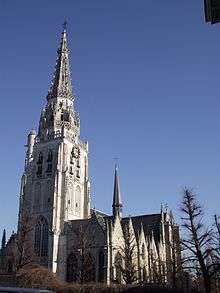Collegial Church of Saint Peter and Saint Guido
The Collegial Church of St. Peter and St. Guido (French: Collégiale Saints-Pierre-et-Guidon, Dutch: Sint-Pieter-en-Sint-Guidokerk) is a Roman Catholic church, built between the 14th and 16th centuries in Brabantine Gothic style, and located in the centre of Anderlecht, Brussels (Belgium). Its neo-Gothic spire dates from the 19th century.
| Collegial Church of St. Peter and St. Guido | |
|---|---|
 Collegial Church of Saint Peter and Saint Guido | |
| 50°50′12″N 4°18′22″E | |
| Location | Place de la Vaillance / Dapperheidsplein B-1070 Anderlecht, Brussels-Capital Region |
| Country | Belgium |
| Denomination | Roman Catholic |
| History | |
| Dedication | Saint Peter and Saint Guy (patron saint of Anderlecht) |
| Architecture | |
| Functional status | Active |
| Heritage designation | Protected[1] |
| Designated | 25/10/1938 |
| Architectural type | Church |
| Style | Brabantine Gothic |
| Years built | 14th–16th centuries (church) 19th century (spire) |
| Completed | 1898 |
| Specifications | |
| Number of spires | 1 |
| Administration | |
| Archdiocese | Mechelen-Brussels |
The church is located on the northern side of the Place de la Vaillance/Dapperheidsplein, not far from Erasmus House, the Old Beguinage of Anderlecht and the Constant Vanden Stock Stadium. This site is served by Saint Guidon/Sint Guido metro station on line 5 of the Brussels metro.
History
The Gothic building that we know today was erected in stages from 1350 to 1527. Jan van Ruysbroeck, the architect of the tower of Brussels' Town Hall, was responsible for the works between 1479 and 1485. The square tower dates from 1517.[2] In the crypt beneath the church lies a very old tombstone with no inscription. A long tradition of pilgrimages consider it to be the tomb of Saint Guy, the "Poor Man of Anderlecht", who died around 1012.[3]
The following centuries, the tomb of Saint Guy began to attract a large number of pilgrims. Restoration works were carried out between 1843 and 1847, under the direction of the architect Jules-Jacques Van Ysendyck, which lead to the discovery of several wall paintings.[4] In 1898, the square tower was surmounted with a spire, giving the church its current appearance.
The church was designated a historic monument on 25 October 1938.[5] It was the subject of a cleaning campaign from 1994 to 1997.
Gallery

Frontal view of the tower 
Main portal 
Interior Tomb of the canons Van Dievoet
See also
- List of churches in Brussels
- Roman Catholicism in Belgium
References
- http://patrimoine.brussels/liens/registre/registre-du-patrimoine-protege-en-region-de-bruxelles-capitale-catalogue-illustre
- "Collegial Church of Saint Peter and Saint Guidon - Bruxelles ma Belle | Un site utilisant WordPress". www.bruxellesmabelle.net. Retrieved 2017-12-27.
- "Saint Guy of Anderlecht". CatholicSaints.Info. 2008-09-14. Retrieved 2017-12-27.
- "An insider's guide to Anderlecht" (PDF).
- http://patrimoine.brussels/liens/registre/registre-du-patrimoine-protege-en-region-de-bruxelles-capitale-catalogue-illustre